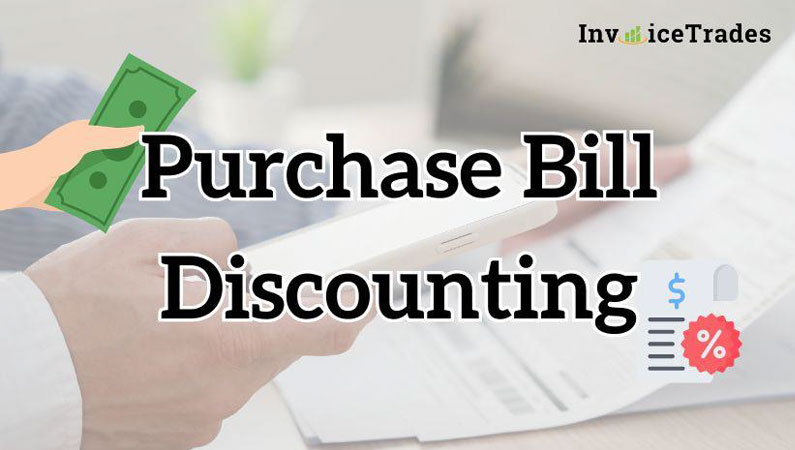
In the dynamic landscape of business finance maintaining optimal cash flow is not just advantageous but critical for the sustainability and growth of any enterprise. However, for businesses operating on credit terms managing accounts payable efficiently can be a daunting task. This is where purchase bill discounting steps in as a strategic financial tool offering a solution to liquidity constraints while simultaneously enhancing relationships with suppliers. In this comprehensive guide, we'll delve deeper into the intricacies of purchase bill discounting exploring its fundamentals, benefits, implementation strategies, real-life examples and best practices.
The process of purchase bill discounting is a well-coordinated dance between buyers, suppliers and financial institutions. It begins with the delivery of goods or services by the supplier to the buyer on credit terms, which results in the issuance of an invoice. The buyer in need of immediate cash flow approaches a financial institution or a discounting platform to request early payment on the invoice. This prompts the financial institution to assess the creditworthiness of the buyer and the validity of the invoice. Once approved, the financial institution like Invoice Trades disburses a discounted amount to the supplier, typically a percentage of the invoice value. The buyer then assumes the responsibility of repaying the financial institution the full invoice amount at a later date, usually upon the invoice due date.
The advantages of purchase bill discounting extend beyond just the realm of improved cash flow. For buyers, it translates into immediate access to liquidity, facilitating better working capital management and the opportunity to capitalize on early payment discounts. Moreover, by ensuring timely payment to suppliers, it fosters stronger relationships, mitigates credit risk and enhances the overall reputation of the buyer. For suppliers, purchase bill discounting serves as a reliable source of liquidity, providing certainty and predictability in cash flow, which in turn supports operational efficiency and growth initiatives.
Before diving headfirst into purchase bill discounting businesses must carefully evaluate several critical factors. The cost of discounting, including interest charges or fees levied by financial institutions is a primary consideration. Equally important is the creditworthiness of both buyers and suppliers, as well as the terms and conditions governing the discounting arrangement. Furthermore businesses should meticulously assess the impact of discounting on cash flow and working capital management to ensure alignment with their overarching financial objectives.
Implementing purchase bill discounting requires a systematic approach. Businesses begin by identifying eligible invoices for discounting, considering factors such as invoice value, payment terms and creditworthiness. Next, they select a suitable financial institution or discounting platform based on criteria such as reputation, cost and service quality. Once a provider is chosen businesses submit invoices for discounting accompanied by any requisite documentation. Upon approval, businesses receive discounted funds from the financial institution, which can then be utilized to meet immediate cash flow needs. Finally, businesses are responsible for repaying the financial institution the full invoice amount on the agreed-upon date, thereby completing the discounting transaction.
To provide a tangible understanding of the practical application of purchase bill discounting, let's examine two real-life scenarios:
Case Study 1: A manufacturing company grapples with a cash flow shortage stemming from delayed payments from customers. Leveraging purchase bill discounting, the company secures immediate liquidity to cover operating expenses and fulfil supplier obligations. Consequently, the company sustains production levels and preserves business continuity.
Case Study 2: A burgeoning small business experiences exponential growth and an uptick in sales volume. However, inefficient management of accounts payable leads to cash flow constraints. Through purchase bill discounting, the business unlocks the cash tied up in outstanding invoices, fuelling continued growth and expansion initiatives.
Best Practices: Navigating the Waters of Discounting Effectively
To maximize the benefits of purchase bill discounting, businesses should adhere to the following best practices:
Conclusion: Charting a Course Towards Financial Resilience
In conclusion, purchase bill discounting stands as a potent tool in the arsenal of financial strategies, offering businesses a pathway to improved liquidity, optimized cash flow, and strengthened relationships with suppliers. By understanding the process, considering key factors and implementing best practices businesses can unlock the full potential of purchase bill discounting paving the way for sustained growth, financial stability and enduring success in their respective endeavours. As businesses navigate the complexities of today's economic landscape purchase bill discounting emerges as a beacon of financial resilience and strategic foresight empowering enterprises to thrive amidst uncertainty and seize opportunities with confidence.
For more information on purchase bill discounting, please visit Invoice Trades. Unlock new possibilities and embark on a journey towards financial empowerment and resilience
Q1: What is purchase bill discounting?
Purchase bill discounting is a financing technique where a buyer obtains early payment on outstanding invoices by discounting them with a financial institution.
Q2: Who benefits from purchase bill discounting?
Both buyers and suppliers benefit from purchase bill discounting, as it improves cash flow, strengthens relationships and reduces credit risk.
Q3: How is the discounting rate determined?
The discounting rate is determined by factors such as the creditworthiness of the buyer, the validity of the invoice and prevailing market conditions.
Q4: What are the key considerations before opting for purchase bill discounting?
Key considerations include evaluating the cost of discounting, assessing the creditworthiness of buyers and suppliers and ensuring alignment with overall financial objectives.